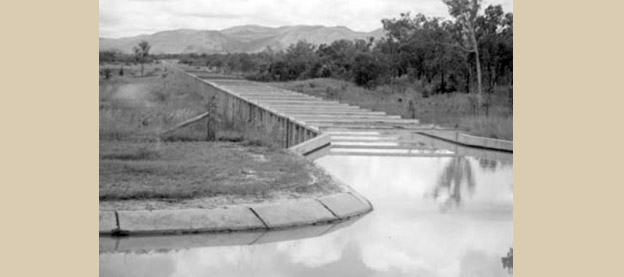
The township of Dimbulah (aboriginal word meaning “long waterhole”) was born after 1906 as a watering place for locomotives travelling from Mareeba to Chillagoe. A hotel opened in 1908.
Originally the town was known as ‘Dimbulah Junction’ as it was the junction of the railway lines to Chillagoe to the west, and Mt Mulligan to the north. Dimbulah is the gateway to the Hodgkinson Goldfield, which was settled in 1876 and lead to the establishment of Cairns as a port.
Dimbulah’s early development was aided by the Wolfram Camp Mines, 18km to the north-west, and the Mount Mulligan coal mine. A spring surfacing behind the present school and police station provided permanent water. William Hambling built the original Dimbulah Homestead in 1919 – this house still stands today, adjacent to the school principal’s residence. The first school in Dimbulah was established in August 1914 on a different site from that of the present school. It was a provisional one and was known as the “Dimbulah Tent School”. Miss Miriam Jacobs (later Mrs Howe) was the first teacher. The Dimbulah State School was opened on 28th September 1914, and its first pupils were children from the families Hay, Fogarty, Grogan, Shanahan, Wallace and Murray. Miss Knox was the teacher in 1915, and Miss Walsh in the 1915-18 years. The first migrant child to be enrolled at the school was Bruna Cibau in 1932, at the time when the first Italians were moving into the area.

Prior to the 1930’s, pastoralism was the major land-use in the district before tobacco growing then began in the Sandy Creek area. Irrigation was introduced when the Bruce Weir, on the Walsh River, was completed around 1947-1948.
Next followed the construction of the Leafgold and Collins Weir (both on the Walsh), and the Solanum Weir on Eureka Creek. The completion of Tinaroo Dam in 1958 provided additional water. The town was connected with electricity at this time also. The scope for farming expanded and a large influx of migrants arrived during this time in the 1950’s.

For many years, Dimbulah was the centre of a thriving tobacco industry. At its peak, there were approximately 800 growers in the area, producing over 8,000 tonnes of tobacco a year; however the last tobacco sales contracts in North Queensland were filled in early 2004 after a Federal Government and industry-funded buyout.
Many other crops have now replaced tobacco.
Text taken from:
1. Scollo, MM and Winstanley, MH [editors]. Tobacco in Australia: Facts and Issues. Third Edition. Melbourne: Cancer Council Victoria; 2008.
2. The Wheelbarrow Way Tourism Directory, 2012. Cairns Outback Tourism Development Association. - - http://queenslandplaces.com.au/dimbulah




